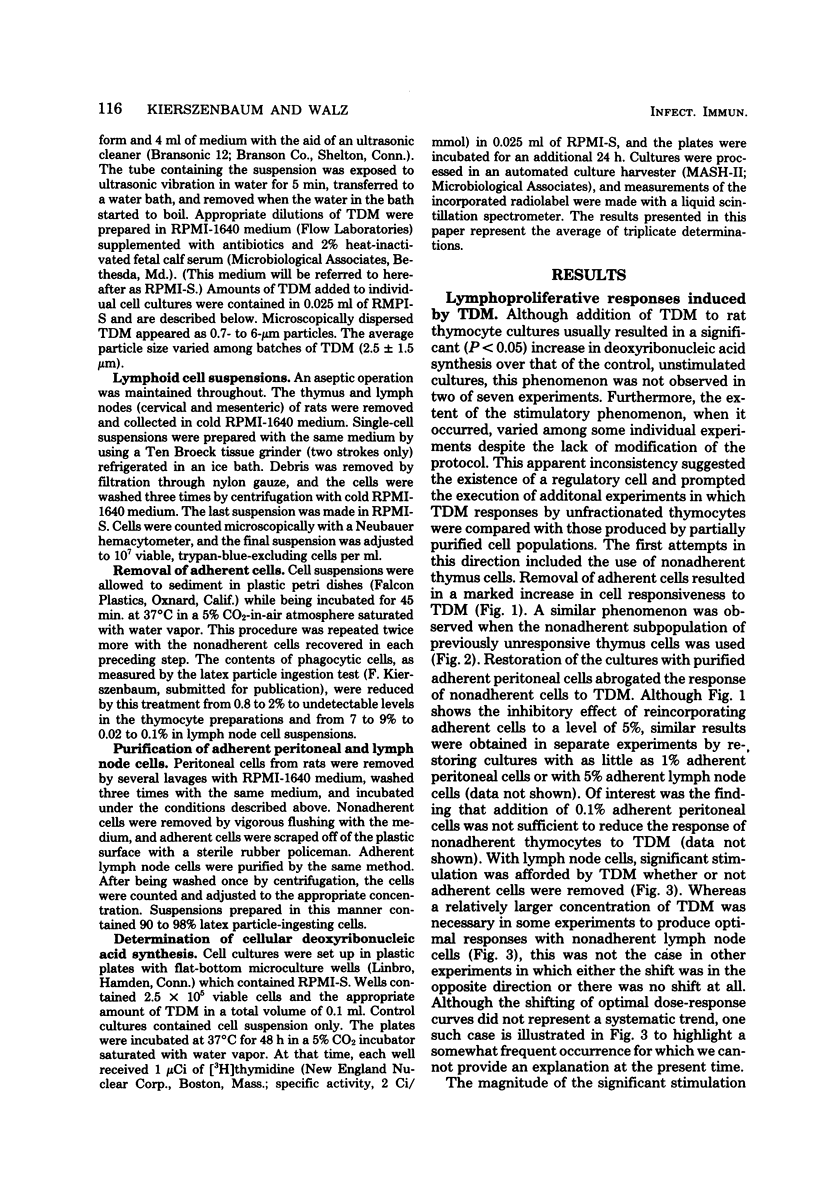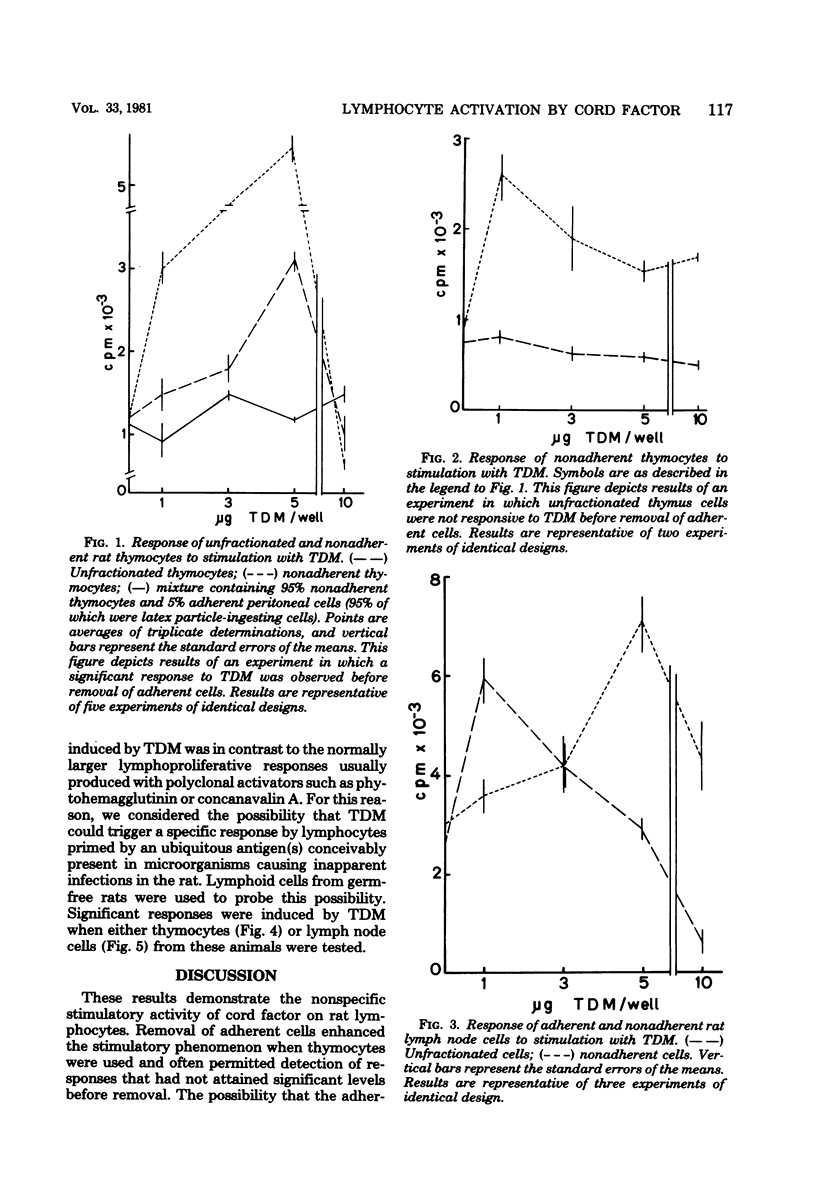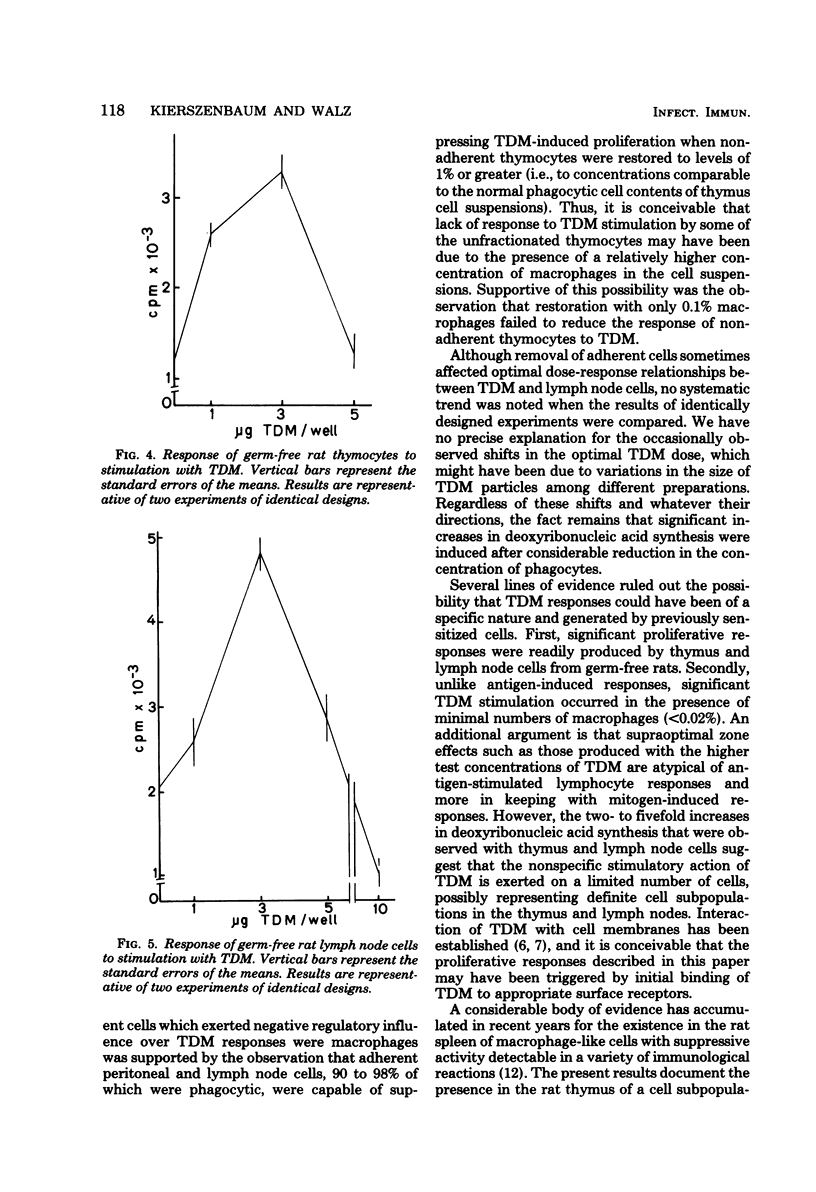Abstract
Cord factor--a mixture of 6,6'-diesters of alpha, alpha-D-trehalose with natural mycolic acids--which is purified from mycobacteria and other microorganisms, is known to have adjuvant activity as well as to enhance nonspecific resistance to infections and tumor development. In this work, trehalose 6,6'-dimycolate (TDM) was found to induce proliferative responses in rat thymus and lymph node cells. With the thymus cells, TDM responses were greater after removal of the adherent cell subpopulation. Consistent with this observation was the finding that addition of phagocytic cells purified from peritoneal or lymph node cell suspensions to nonadherent thymocytes abrogated the response of thymocytes to TDM. With the lymph node cells, the presence or removal of adherent cells had no major consequence on the TDM-induced proliferative response, since similar increases in deoxyribonucleic acid synthesis were observed with unfractionated and nonadherent cells. The difference between the sensitivities of thymus cells and lymph node cells to regulation by adherent cells indicated the existence of more than one type of TDM responder cell in rats. TDM also displayed marked stimulatory activity on thymus and lymph node cells from germ-free rats, ruling out the possibility that TDM might have triggered a specific, secondary, in vitro immune response. Expansion of a selected cell population(s) triggered by TDM may be involved in the manifestation of adjuvant activity and possibly other immunological properties of cord factor.
Full text
PDF




Selected References
These references are in PubMed. This may not be the complete list of references from this article.
- Asselineau C., Asselineau J. Trehalose-containing glycolipids. Prog Chem Fats Other Lipids. 1978;16:59–99. doi: 10.1016/0079-6832(78)90037-x. [DOI] [PubMed] [Google Scholar]
- BLOCH H. Studies on the virulence of tubercle bacilli; isolation and biological properties of a constituent of virulent organisms. J Exp Med. 1950 Feb;91(2):197-218, pl. doi: 10.1084/jem.91.2.197. [DOI] [PMC free article] [PubMed] [Google Scholar]
- Bekierkunst A. Acute granulomatous response produced in mice by trehalose-6,6-dimycolate. J Bacteriol. 1968 Oct;96(4):958–961. doi: 10.1128/jb.96.4.958-961.1968. [DOI] [PMC free article] [PubMed] [Google Scholar]
- Bekierkunst A., Levij I. S., Yarkoni E. Suppression of urethan-induced lung adenomas in mice treated with trehalose-6,6-dimycolate (cord factor) and living bacillus Calmette Guérin. Science. 1971 Dec 17;174(4015):1240–1242. doi: 10.1126/science.174.4015.1240. [DOI] [PubMed] [Google Scholar]
- Goren M. B. Mycobacterial lipids: selected topics. Bacteriol Rev. 1972 Mar;36(1):33–64. doi: 10.1128/br.36.1.33-64.1972. [DOI] [PMC free article] [PubMed] [Google Scholar]
- Kato M. Studies of a biochemical lesion in experimental tuberculosis in mice. IX. Response of respiratory enzymes in immune mouse liver to cord factor and tuberculin PPD. Am Rev Respir Dis. 1969 Jan;99(1):112–115. doi: 10.1164/arrd.1969.99.1.112. [DOI] [PubMed] [Google Scholar]
- Kato M., Tamura T., Silve G., Asselineau J. Chemical structure and biochemical activity of cord factor analogs. A comparative study of esters of methyl glucoside and non-hydroxylated fatty acids. Eur J Biochem. 1978 Jul 3;87(3):497–504. doi: 10.1111/j.1432-1033.1978.tb12400.x. [DOI] [PubMed] [Google Scholar]
- Lederer E. Cord factor and related trehalose esters. Chem Phys Lipids. 1976 Mar;16(2):91–106. doi: 10.1016/0009-3084(76)90001-3. [DOI] [PubMed] [Google Scholar]
- Mattingly J. A., Eardley D. D., Kemp J. D., Gershon R. K. Induction of suppressor cells in rat spleen: influence of microbial stimulation. J Immunol. 1979 Mar;122(3):787–790. [PubMed] [Google Scholar]
- Ofek I., Bekierkunst A. Chemotactic response of leukocytes to cord factor (trehalose-6,6'-dimycolate). J Natl Cancer Inst. 1976 Dec;57(6):1379–1381. doi: 10.1093/jnci/57.6.1379. [DOI] [PubMed] [Google Scholar]
- SUTER E., KIRSANOW E. M. Hyperreactivity to endotoxin in mice infected with mycobacteria. Induction and elicitation of the reactions. Immunology. 1961 Oct;4:354–365. [PMC free article] [PubMed] [Google Scholar]
- Saito R., Nagao S., Takamoto M., Sugiyama K., Tanaka A. Adjuvanticity (immunity-inducing property) of cord factor in mice and rats. Infect Immun. 1977 Jun;16(3):725–729. doi: 10.1128/iai.16.3.725-729.1977. [DOI] [PMC free article] [PubMed] [Google Scholar]
- Saito R., Tanaka A., Sugiyama K. Cord factor not toxic in rats. Am Rev Respir Dis. 1975 Oct;112(4):578–580. doi: 10.1164/arrd.1975.112.4.578. [DOI] [PubMed] [Google Scholar]
- Tenu J. P., Lederer E., Petit J. F. Stimulation of thymocyte mitogenic protein secretion and of cytostatic activity of mouse peritoneal macrophages by trehalose dimycolate and muramyldipeptide. Eur J Immunol. 1980 Aug;10(8):647–653. doi: 10.1002/eji.1830100813. [DOI] [PubMed] [Google Scholar]
- Yarkoni E., Bekierkunst A. Nonspecific resistance against infection with Salmonella typhi and Salmonella typhimurium induced in mice by cord factor (trehalose-6,6'-dimycolate) and its analogues. Infect Immun. 1976 Nov;14(5):1125–1129. doi: 10.1128/iai.14.5.1125-1129.1976. [DOI] [PMC free article] [PubMed] [Google Scholar]
- Yarkoni E., Rapp H. J. Tumor regression after intralesional injection of mycobacterial components emulsified in 2,6,10,15,19,23-hexamethyl-2,6,10,14,18,22-tetracosahexaene (squalene), 2,6,10,15,19,23-hexamethyltetracosane (squalane), peanut oil, or mineral oil. Cancer Res. 1979 May;39(5):1518–1520. [PubMed] [Google Scholar]


